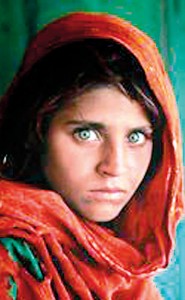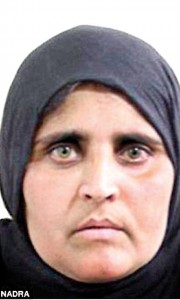Sunday Times 2
Iconic ‘Afghan Girl’ at the centre of Pakistani corruption row
She was the green-eyed ‘Afghan Girl’ who shot to global fame when a haunting picture of her appeared on the cover of a 1985 issue of National Geographic magazine.
Now a picture of Sharbat Gula is in the news again – but it’s a very different image.
 |  |
| Sharbat Gula shot to fame as a green-eyed 12-year-old on the cover of National Geographic in 1985 (left), but a more recent image of her (right) is circulating in media as part of a row about corruption in Pakistan. It was taken from her identity card – a document she technically shouldn’t have been allowed to acquire (AFP/NADRA) | |
A recent picture of Gula, looking less striking, is washing around in a row about corruption in Pakistan.
The haunting image of the then 12-year-old Gula, taken in a refugee camp by photographer Steve McCurry, became the most famous cover image in National Geographic’s history.
After a 17-year search, McCurry tracked Gula down to a remote Afghan village in 2002 where she was living married to a baker and the mother of three daughters.
However, she’s being investigated because Pakistani officials discovered she was living in the country on fraudulent identity papers.
This week the picture from her computerised national identity card surfaced in national media. It’s an ID card that as an Afghan national, she’s not allowed to have.
Pakistani officials say that Gula applied for a Pakistani identity card in the northwestern city of Peshawar in April 2014, using the name Sharbat Bibi.
She was one of thousands of Afghan refugees who managed to dodge Pakistan’s computerised system and to get an identity card last year.
Faik Ali Chachar, a spokesman for the National Database and Registration Authority (NADRA), told AFP the Federal Investigation Agency was probing Gula’s case.
‘This is one of the thousands of cases which was detected last year and sent to the FIA. We are waiting for the findings of the inquiry,’ Chachar said.
‘Our vigilance department detected (the) Sharbat Bibi case in August 2014 and sent it to FIA for further investigation the same month.’
Many Afghan refugees try to get Pakistani ID cards every day using fake documents, Chachar said.
‘Around 23,000 cards of Afghan refugees were detected and blocked’ in the 12 years since NADRA was launched, Chachar said.
In her official registration with NADRA, Gula said she was born in January 1969 and gave Peshawar as her place of birth.
The photo attached to the application has the same piercing green eyes and the same sculpted face seen in McCurry’s famous image only older, lined by age and surrounded by a black hijab covering her hair completely.
An AFP reporter visited the poor Peshawar neighbourhood given as Gula’s address in her papers, where residents said she had been living with her husband, who worked in a local bakery, but had left a month ago.
A senior official in NADRA’s Peshawar office, where the cards were issued, confirmed the investigation and told AFP that Sharbat Bibi and her two sons Rauf Khan and Wali Khan were issued cards on the same day.
He said all the documents she used to get the card, which only Pakistani citizens are entitled to, were fake and her ‘sons’ were likely also not related to her.
© Daily Mail, London

